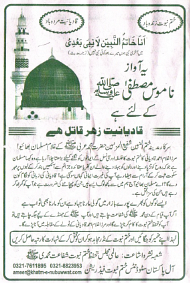Worldview: The other Pakistani crisis
Intolerance and violence threaten to tear the country to pieces.
By Trudy Rubin
Inquirer Opinion Columnist
Inquirer Opinion Columnist
A shocking e-mail on Monday informed me of a Philadelphian murdered in Pakistan.
Habib Peer, 60, was a hardworking Pakistani American who had raised three children and run two businesses in the city. He considered himself a devout Muslim and was a leader in his Ahmadiyya Muslim community. Last week, he was shot dead by masked men in the southern Pakistani city of Sanghar, where he was helping the family of his brother - who had been murdered four years before.
Both brothers were killed by militants who believe the Ahmadis are apostates. Since 1974, Pakistan’s constitution has labeled its two to four million Ahmadis “non-Muslim” because their beliefs contradict traditional Islam. (They follow a 19th-century mystic they believe was the messiah predicted by the prophet Muhammad.) In no Muslim country is the repression of Ahmadis so severe or so officially sanctioned as in Pakistan.
Peer’s death, however, exposes a crisis affecting all Pakistanis. It reflects a struggle for the soul of the country as daunting as the physical struggle to survive this month’s devastating floods.
Pakistan faces a Herculean challenge in coping with flood damage, and Muslim militants are eager to take advantage. As Pakistan’s leaders now recognize, these militants present a huge threat to their (nuclear-armed) state.
A recent security assessment by Pakistan’s military spy agency concluded, for the first time, that the biggest threat to national security comes from Islamic militants, not India. Some of these militants are probably providing shelter for al-Qaeda’s leadership, including Osama bin Laden, and the Pakistani army is targeting some groups.
Yet there are other jihadis dedicated to sectarian murder that are not on the military’s hit list. Some of these militants were originally trained by Pakistani security services to fight against India in the disputed territory of Kashmir.
Sipah-e-Sahaba, for example, openly calls for the slaying of Shiite Muslims, who make up about 10 to 15 percent of the population; it continues to operate freely. The Pakistani elite largely stays silent, and sectarian violence grows.
In April, I visited a Shiite friend in Karachi who was nearly killed in December, when a suicide bomber blew up 43 people during the Shiite religious celebration of Ashura. Her back and thighs were penetrated by large shards of metal from the bomb, which went off five feet from her; her brother and sister-in-law were killed.
Militants have also been attacking Sufi shrines, which they consider irreligious, although Sufi saints and shrines are highly regarded in South Asia. Pakistani Christians are attacked, too. Fueled by young graduates of radical religious schools, sectarian and ethnic violence is tearing at the social fabric of Karachi, Pakistan’s largest city.
Yet Pakistan’s leaders rarely stand up to religious fanatics who target fellow Pakistanis. When it comes to Ahmadis, the state practically cheers the violence on.
On May 28, gunmen struck at two Ahmadi mosques in Lahore, killing 93 people. After this outrage, the powerful Pakistani politician Nawaz Sharif (whose party has shown sympathy for militants) had the decency to insist that his Ahmadi “brothers and sisters” are an “asset to the country.” He was denounced by religious parties and clerics around the country.
Pakistan’s founder, Mohammed Ali Jinnah, who envisioned an inclusive and tolerant state, must be turning in his grave.
As Pakistanis begin to recover from the floods, they must decide what kind of country they want to live in. Their only Nobel Prize winner, physicist Abdus Salam, was an Ahmadi; when the physics faculty at Quaid-i-Azam University invited him to lecture in 1979, it was thwarted by a religious student group that threatened violence. Is this the country Pakistanis want?
The endless sectarian killings show - contrary to legions of Pakistani conspiracy theorists - that the country is besieged not by the West, but by Muslim militants who use violence.
In the Peer case, militants killed members of a community that opposes religious wars and bloodshed. Will Pakistan’s leaders have the courage to denounce these and other sectarian murders? Will they change the laws that expose Ahmadis to blasphemy charges and death?
To recover from the physical challenge of the flood, Pakistanis will have to pull together in spirit, not pit different communities against one another. The rest of the world can help Pakistan with rebuilding, but only Pakistanis can make their country whole.
Both brothers were killed by militants who believe the Ahmadis are apostates. Since 1974, Pakistan’s constitution has labeled its two to four million Ahmadis “non-Muslim” because their beliefs contradict traditional Islam. (They follow a 19th-century mystic they believe was the messiah predicted by the prophet Muhammad.) In no Muslim country is the repression of Ahmadis so severe or so officially sanctioned as in Pakistan.
Peer’s death, however, exposes a crisis affecting all Pakistanis. It reflects a struggle for the soul of the country as daunting as the physical struggle to survive this month’s devastating floods.
Pakistan faces a Herculean challenge in coping with flood damage, and Muslim militants are eager to take advantage. As Pakistan’s leaders now recognize, these militants present a huge threat to their (nuclear-armed) state.
A recent security assessment by Pakistan’s military spy agency concluded, for the first time, that the biggest threat to national security comes from Islamic militants, not India. Some of these militants are probably providing shelter for al-Qaeda’s leadership, including Osama bin Laden, and the Pakistani army is targeting some groups.
Yet there are other jihadis dedicated to sectarian murder that are not on the military’s hit list. Some of these militants were originally trained by Pakistani security services to fight against India in the disputed territory of Kashmir.
Sipah-e-Sahaba, for example, openly calls for the slaying of Shiite Muslims, who make up about 10 to 15 percent of the population; it continues to operate freely. The Pakistani elite largely stays silent, and sectarian violence grows.
In April, I visited a Shiite friend in Karachi who was nearly killed in December, when a suicide bomber blew up 43 people during the Shiite religious celebration of Ashura. Her back and thighs were penetrated by large shards of metal from the bomb, which went off five feet from her; her brother and sister-in-law were killed.
Militants have also been attacking Sufi shrines, which they consider irreligious, although Sufi saints and shrines are highly regarded in South Asia. Pakistani Christians are attacked, too. Fueled by young graduates of radical religious schools, sectarian and ethnic violence is tearing at the social fabric of Karachi, Pakistan’s largest city.
Yet Pakistan’s leaders rarely stand up to religious fanatics who target fellow Pakistanis. When it comes to Ahmadis, the state practically cheers the violence on.
On May 28, gunmen struck at two Ahmadi mosques in Lahore, killing 93 people. After this outrage, the powerful Pakistani politician Nawaz Sharif (whose party has shown sympathy for militants) had the decency to insist that his Ahmadi “brothers and sisters” are an “asset to the country.” He was denounced by religious parties and clerics around the country.
Pakistan’s founder, Mohammed Ali Jinnah, who envisioned an inclusive and tolerant state, must be turning in his grave.
As Pakistanis begin to recover from the floods, they must decide what kind of country they want to live in. Their only Nobel Prize winner, physicist Abdus Salam, was an Ahmadi; when the physics faculty at Quaid-i-Azam University invited him to lecture in 1979, it was thwarted by a religious student group that threatened violence. Is this the country Pakistanis want?
The endless sectarian killings show - contrary to legions of Pakistani conspiracy theorists - that the country is besieged not by the West, but by Muslim militants who use violence.
In the Peer case, militants killed members of a community that opposes religious wars and bloodshed. Will Pakistan’s leaders have the courage to denounce these and other sectarian murders? Will they change the laws that expose Ahmadis to blasphemy charges and death?
To recover from the physical challenge of the flood, Pakistanis will have to pull together in spirit, not pit different communities against one another. The rest of the world can help Pakistan with rebuilding, but only Pakistanis can make their country whole.




